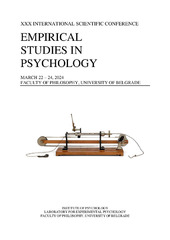Приказ основних података о документу
Our unique dance: Deviations in the appearance of the phases of the couples’ contact episode in the initial stage of couple therapy
| dc.creator | Jovanović, Dušanka | |
| dc.creator | Grbić, Sanja | |
| dc.date.accessioned | 2024-03-18T18:16:26Z | |
| dc.date.available | 2024-03-18T18:16:26Z | |
| dc.date.issued | 2024 | |
| dc.identifier.isbn | 978-86-6427-284-1 | |
| dc.identifier.uri | http://reff.f.bg.ac.rs/handle/123456789/6285 | |
| dc.description.abstract | Relying on the theory of Gestalt therapy, in this study we sequenced in-session couple dynamics aiming to identify aspects of communication that facilitate or hinder constructive exchange. Initially, we identified five phases of a contact episode, each of which has several variations: (a) Emergence of a need, (b) Habitual attempt to satisfy the need, (c) Impasse, (d) Novelty and regression, and (e) Constructive dialogical relationship. These phases are tentatively successive, i.e., there are regularities in their appearance. However, deviations in their progression were observed, which could be utilized in process diagnostics in the initial stage of couple therapy. Mapping these irregularities is the aim of this paper. The participants were six heterosexual couples (29–45 years old, ≥2 years together, 5 without children). The data was collected through videotaping the 2nd therapy session. The material for the analysis were contact episodes: couple interaction regarding the self-selected topic, during which the therapist assumed the observer role. Thematic analysis was applied by the authors, with the interpretation based on a dialogical approach and theory of Gestalt therapy. The first variability is that the appearance of the latter phases is not mandatory (e.g., unwavering defensiveness keeps the partners in the third phase, Impasse). Second, the order of the phases is not certain (e.g., the prominent power imbalance within the couple leads to skipping the Impasse). Third, the duration of the phases is not uniform (e.g., deflection prolongs the Emergence of a need phase). Fourth, the contact episode development is characterized by circularity, i.e., returning to previous stages (e.g., when partners are unequally ready for novelty, they create back-and-forth movement: one introduces constructive dialogue characteristic of later stages, the other contributes to regressing and reenacting the scheme). Fifth, if a couple has two contact episodes within the same session, their course may differ: in the second episode, the initial stages are condensed or completely skipped, and the couple begins the exchange with a rapid jump to chronologically later stages (e.g., to the Impasse – repeating their scheme until exhaustion is reached). Finally, particular variations of one phase are more often paired with specific variations of other phases of the contact episode. The findings contribute to the therapists' efforts to fine-tune their interventions to the here-and-now developments in order to facilitate the supportive aspects of dialogical relationship. | sr |
| dc.language.iso | en | sr |
| dc.publisher | Belgrade: Institute of Psychology, Laboratory for Experimental Psychology, Faculty of Philosophy, University of Belgrade | sr |
| dc.relation | info:eu-repo/grantAgreement/MESTD/inst-2020/200163/RS// | sr |
| dc.rights | openAccess | sr |
| dc.rights.uri | https://creativecommons.org/licenses/by/4.0/ | |
| dc.source | Book of Abstracts, XXX International Scientific Conference Empirical Studies in Psychology, Faculty of Philosophy, University of Belgrade, March 22-24. 2024. | sr |
| dc.subject | in-session couple dynamics | sr |
| dc.subject | couple therapy | sr |
| dc.subject | dialogical approach | sr |
| dc.subject | qualitative study | sr |
| dc.subject | gestalt therapy | sr |
| dc.title | Our unique dance: Deviations in the appearance of the phases of the couples’ contact episode in the initial stage of couple therapy | sr |
| dc.type | conferenceObject | sr |
| dc.rights.license | BY | sr |
| dc.citation.spage | 133 | |
| dc.identifier.fulltext | http://reff.f.bg.ac.rs/bitstream/id/16023/bitstream_16023.pdf | |
| dc.identifier.rcub | https://hdl.handle.net/21.15107/rcub_reff_6285 | |
| dc.type.version | publishedVersion | sr |

